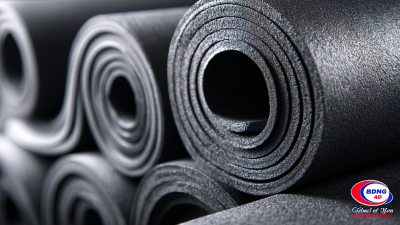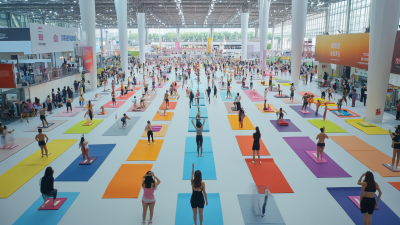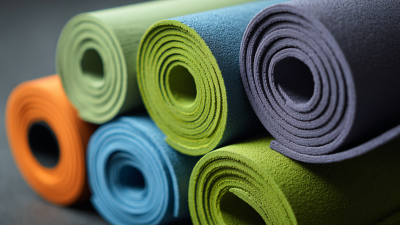When it comes to creating an effective home workout space, choosing the right equipment is crucial, and one often-overlooked component is the flooring. Rubber Exercise Mats are increasingly recognized for their versatility and durability, making them an essential element in any fitness regimen. According to a report by Allied Market Research, the global rubber matting market is projected to reach $3.3 billion by 2025, driven by the growing demand for versatile and impact-resistant flooring solutions for home gyms. These mats not only provide exceptional grip and cushioning but also help protect floors from heavy equipment and wear. As home workouts gain popularity—accelerated by the pandemic, which saw home fitness industry growth by 170% in 2020—understanding the benefits and specifications of Rubber Exercise Mats becomes paramount for fitness enthusiasts seeking to enhance their workout experience.

When selecting rubber exercise mats for home workouts, it's essential to understand the different types available on the market. One prominent type is the interlocking rubber mat, which allows for customizable layouts and easy storage. This design is particularly useful for dedicated workout spaces where space flexibility is crucial. Interlocking mats are often thicker and provide excellent shock absorption, making them ideal for activities such as weightlifting or high-impact cardio.

Another option is the rolled rubber mat, which is typically larger and more suited for covering expansive floor areas. These mats are permanent fixtures that offer a seamless surface, reducing the risk of tripping during exercises. Rolled mats are often preferred in home gyms or areas that see heavy use, as they are durable and easy to clean. Moreover, some mats come with special features like antimicrobial properties, enhancing hygiene for regular workouts. Selecting the right type of rubber exercise mat ultimately depends on your specific workout needs and the available space in your home.
When selecting rubber exercise mats for home workouts, there are several key features to consider to ensure you make the best choice for your fitness routine. First and foremost, thickness plays a critical role. A thicker mat generally provides more cushioning and support, which is especially important for high-impact exercises and activities that require floor work. Look for mats that are at least 0.5 inches thick to ensure adequate protection for your joints and comfort during extended use.

Another important feature is the grip and surface texture of the mat. A mat with a non-slip surface is essential to prevent accidents during workouts, particularly when performing dynamic movements or weightlifting. Additionally, consider the durability and material quality; rubber mats are known for their resilience against wear and tear, but not all rubber is created equal. High-density rubber tends to be more durable and can withstand demanding workouts, while also providing excellent shock absorption. Finally, check for ease of cleaning, as maintaining hygiene is vital for any exercise space. A mat that can be easily wiped down or washed will help prolong its lifespan and keep your workout area fresh.
When selecting rubber exercise mats for home workouts, it's crucial to consider both thickness and density to best meet your needs. Generally, thicker mats (around 1/2 inch or more) provide more cushioning and support, ideal for high-impact exercises like jumping or bodyweight workouts. On the other hand, thinner mats (1/4 inch) offer stability, making them suitable for activities requiring balance, such as yoga or pilates. A recent industry report highlights that the demand for thicker mats has been growing due to increased participation in home fitness, suggesting a potential CAGR of up to 15% in this segment.
Density also plays a significant role in mat performance. Higher density mats tend to be more durable and resilient under pressure, which is important for activities that involve heavy weights or intense movements. For instance, mats with density ratings above 60 durometer are recommended for serious weight training, ensuring they withstand repeated use without losing form. Tips for choosing the right mat include considering the type of workouts you’ll be doing and evaluating the space available in your home gym to select an appropriately sized mat that complements your fitness regime.
When it comes to home workouts, choosing the right rubber exercise mat is crucial for both performance and safety. Top brands like Liforme, Manduka, and ProForm offer high-quality mats that can withstand intense workouts while providing optimal support. These brands are known for their durability, grip, and comfort, making them ideal for various exercises, from yoga to high-intensity interval training. Look for mats that are made from eco-friendly materials to ensure you're making a sustainable choice.
**Tips:** When selecting a rubber exercise mat, consider the thickness that suits your workout style. Thicker mats provide more cushioning, which is beneficial for floor exercises but can sometimes hinder stability for balance workouts. Additionally, ensure the mat has a non-slip surface to keep you safe during workouts. Check user reviews to gain insights into the durability and performance of the mats over time, as firsthand experiences can guide you in making the right choice.
Another recommended brand is BalanceFrom, known for their versatile range and affordability. They offer mats with excellent anti-tear properties, catering to everything from yoga practices to vigorous strength training. As you shop, take note of dimensions and weight; a portable mat can be a lifesaver for home gyms with limited space, allowing you to easily store or transport your workout equipment.
To ensure your rubber exercise mats remain in excellent condition, regular maintenance is key. Start by cleaning the mats after each use to prevent the buildup of dirt and sweat. A simple solution of warm water and mild soap can effectively remove grime without damaging the rubber. Avoid harsh chemicals, as they can deteriorate the material over time. Use a soft cloth or sponge for the cleaning process, and remember to thoroughly rinse the mats to eliminate any soap residue.
In addition to routine cleaning, it's important to store your mats properly. When not in use, roll them up instead of folding, as this helps maintain their shape and prevents creasing. Keep them in a cool, dry place away from direct sunlight, which can cause fading and cracking. If your mats become sticky or lose their grip, consider applying a light dusting of cornstarch to restore their texture. By following these simple maintenance tips, you can extend the life of your rubber exercise mats and ensure they remain a reliable companion for your home workouts.






